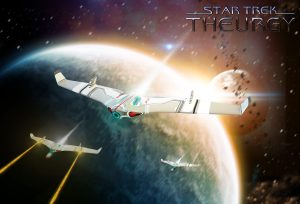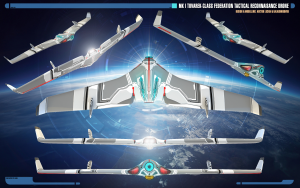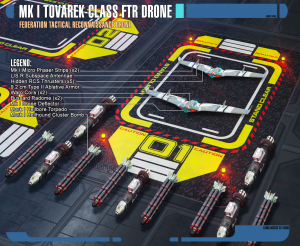Mk I Tovarek-class FTR Drone
From Star Trek: Theurgy Wiki

| |
| Name: | Mk I Tovarek-class FTR Drone |
| Starship Type: | UAV Warp Drone |
| Production Status: | Prototype Testing Stage |
| Role: |
|
| Constructed: | Black Opal & the USS Theurgy |
| Commissioned: | March 19th, 2381 |
| Dimensions: |
|
| Mass (w. Standard Armament): | 25 700 000 kg |
| Technical Specifications | Advantages
|
| Standard Crew Complement: |
|
| Warp & Impulse Speeds: |
|
| Tactical Specs: |
|
| Defensive Specs: |
|
| Engine Specs: |
|
| Other Systems |
|
| Sensors |
|

| |
UNDER CONSTRUCTION
These are the prototype warp fighters that were commissioned to the USS Theurgy at the end of the 24th century. There were originally 16 warp fighters on the Theurgy, and they were flown by the Lone-Wolves squadron.
Production History
[Insert Data]
External Hard-point Options
Aside from the phaser strips,the drones can use one hard-point optin during missions, as listed below.
Mk XXVII Photon Torpedo
Standard photon torpedo ordinance. Explosion is a matter-antimatter reaction producing large amounts of gamma waves as its primary means of destruction. While smaller in size, and harder to target mid-flight, each torpedo has the approximate yield of 70 % compared to the Mk IV (the kind that Federation starships launch from their torpedo bays). This torpedo is deployed in the wing-mounted additional torpedo launchers (see above).
Mk Q-IV Quantum Torpedo
An improvement of the Mk XXVII photon torpedo with a higher yield, comparable to that of photon torpedo mounted on Federation Starships. This was a tactical quantum weapon, that utilised a plasma warhead and casings similar in shape to photon torpedoes. The explosion leaves an antimatter residue and although they were powerful weapons, even a direct hit from a quantum torpedo might not destroy neutronium alloyed targets.
EMP Torpedo
Creates the electromagnetic pulse similar to what is created from the high atmosphere detonation of a nuclear warhead. A well shielded craft will withstand this easily but the weapon detonates in a burst of broadband, high-intensity electromagnetic energy, capable of disrupting magnetic fields and producing current or voltage surges in conductive materials via magnetic induction.
Indirect damage to enemy hardware might prove substantial, and while it has a greater chance of disabling a small craft, the plasma surges may wound or kill soft targets if they are directly exposed.




